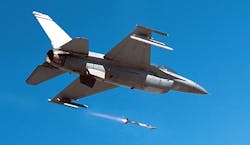Officials of the U.S. Naval Air Systems Command at Patuxent River Naval Air Station, Md., are asking Raytheon to replace the control actuation system, inertial measurement unit, and electronics unit processor in the AIM-9X Block II missile under terms of the contract. AIM stands for air intercept missile.
The contract modification also calls for Raytheon to improve the AIM-9X Block II's insensitive munitions performance in hardware and flight software versions 9.4X, 9.15X and 10.X. The upgrades are intended to extend the weapon's range and address existing obsolescence issues.
The upgraded missiles will be for the U.S. Air Force and Navy, as well as for the governments of Turkey, Oman, Belgium, The Netherlands, Singapore, Malaysia, and Morocco.
Insensitive munitions, mandated by U.S. law, refer to weapons that only burn, rather than explode, when subjected to unintentional slow or fast heating, bullets, shrapnel, shaped charges, or the detonation of another nearby munition. Military officials want to ensure the AIM-9X Block II does not explode unintentionally due to accidents or combat damage to safeguard military personnel and equipment from weapons-related accidents.
The Raytheon AIM-9X Block II Sidewinder is the latest version of the missile. The initial version of the AIM 9X entered service in November 2003 on the Air Force F-15C jet fighter and on the Navy F/A-18C strike fighter. The initial AIM 9X version featured an imaging infrared focal plane array (FPA) seeker with 90-degree off-boresight capability, compatibility with helmet-mounted displays, and a 3-D thrust-vectoring control (TVC) system to enhance turn capability.
An advanced helmet-mounted display can enable the pilot to lock the AIM-9X missile's seeker on its target simply by looking at the target. The missile has lower aerodynamic drag that its predecessors for improved range and speed. The AIM-9X also includes an internal cooling system and an electronic safe-and-arm device to reduce the missile's minimum range, as well as a reprogrammable infrared counter-countermeasures (IRCCM) capability.
The IRCCM capability working together with the missile's infrared focal plan array seeker enhance the weapon's ability to acquire targets below the aircraft in electro-optical clutter and defeat advanced countermeasures.
Related: Pentagon eyes AIM-9X-2 Sidewinder air-to-air missile sale for Netherlands F-16 jet fighters
The AIM-9X Block II also has lock-on after launch capability with a datalink, so the missile can be launched and then directed to its target by advanced aircraft such as the F-35 Lightning II joint strike fighter and the F-22 Raptor advanced tactical fighter.
The AIM-9X Block II adds a redesigned fuze and a digital ignition safety device that enhances ground handling and in-flight safety. The Block II variant also features updated electronics that enable lock-on-after-launch capability using a new weapon datalink to support beyond visual range engagements.
The contract comprises $23.6 million for the Air Force; $8.2 million for the Navy; $4.1 million for Turkey; $2.6 million for Oman; $2.1 million for Belgium; $1.7 million for The Netherlands; $980,000 for Singapore; $701,394 for Malaysia; and $70,000 for Morocco.
For this contract Raytheon will do the work in Tucson, Ariz.; Minneapolis; Pinellas Park, Fla.; and Andover, Mass., and should be finished by July 2015.
For more information contact Raytheon Missile Systems online at www.raytheon.com, or Naval Air Systems Command at www.navair.navy.mil.



